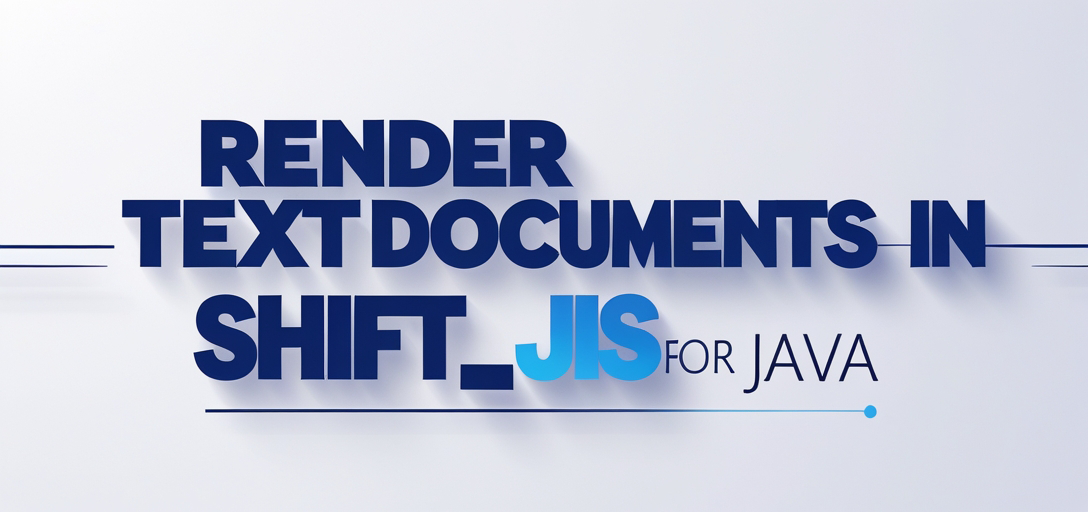Render Text Documents in Shift_JIS Using GroupDocs.Viewer for Java
Introduction
Are you facing challenges rendering text documents encoded in Shift_JIS using Java? You’re not alone! Many developers encounter difficulties with different character encodings, particularly for languages like Japanese. This tutorial will guide you through loading and rendering text documents with a specific charset using GroupDocs.Viewer for Java.

What You’ll Learn:
- Configuring GroupDocs.Viewer for Java
- Loading documents with Shift_JIS encoding
- Setting up output directories for rendered files
- Practical applications in real-world scenarios
Let’s start by covering the prerequisites!
Prerequisites
Before you begin, ensure that you have:
- Required Libraries and Dependencies: GroupDocs.Viewer for Java library version 25.2 or later.
- Environment Setup Requirements: A working Java development environment (preferably JDK 8+).
- Knowledge Prerequisites: Basic understanding of Java programming and familiarity with Maven dependency management.
Setting Up GroupDocs.Viewer for Java
To get started, set up your project with the necessary dependencies. If you’re using Maven, add the following configuration to your pom.xml:
<repositories>
<repository>
<id>repository.groupdocs.com</id>
<name>GroupDocs Repository</name>
<url>https://releases.groupdocs.com/viewer/java/</url>
</repository>
</repositories>
<dependencies>
<dependency>
<groupId>com.groupdocs</groupId>
<artifactId>groupdocs-viewer</artifactId>
<version>25.2</version>
</dependency>
</dependencies>
License Acquisition Steps:
- Start with a free trial to explore the features.
- For extended use, apply for a temporary license or purchase one through GroupDocs’ official website.
Once your setup is ready, let’s move on to implementing our solution!
Implementation Guide
Loading Documents with Specific Charset
Overview
This feature demonstrates how to load and render text documents encoded in Shift_JIS using GroupDocs.Viewer for Java. It’s particularly useful when working with Japanese documents requiring specific character encoding.
Step-by-Step Implementation
1. Define the Input File Path
First, specify the location of your input file. Replace YOUR_DOCUMENT_DIRECTORY with the actual directory containing your document:
String filePath = "YOUR_DOCUMENT_DIRECTORY/SAMPLE_TXT_SHIFT_JS_ENCODED";
2. Set Up Output Directory Define where you want to save the rendered HTML files:
Path outputDirectory = Paths.get("YOUR_OUTPUT_DIRECTORY");
Path pageFilePathFormat = outputDirectory.resolve("page_{0}.html");
3. Configure LoadOptions with Specific Charset
Create a LoadOptions object and specify the file type and charset:
LoadOptions loadOptions = new LoadOptions();
loadOptions.setFileType(FileType.TXT);
loadOptions.setCharset(Charset.forName("shift_jis"));
4. Set Up HtmlViewOptions for Embedded Resources Configure how the document will be rendered in HTML format with embedded resources:
HtmlViewOptions viewOptions = HtmlViewOptions.forEmbeddedResources(pageFilePathFormat);
5. Load and Render the Document
Finally, use the Viewer class to load and render your document:
try (Viewer viewer = new Viewer(filePath, loadOptions)) {
viewer.view(viewOptions);
}
Troubleshooting Tips
- Ensure the file path is correct and accessible.
- Verify that the charset specified matches the encoding of your text document.
Configuring Output Directory for Rendering
Overview
This feature guides you through setting up an output directory where rendered files will be stored. This is essential for organizing your HTML outputs.
1. Set Path for Output Directory As shown earlier, define the path and format for storing the rendered HTML pages:
Path outputDirectory = Paths.get("YOUR_OUTPUT_DIRECTORY");
Path pageFilePathFormat = outputDirectory.resolve("page_{0}.html");
This configuration ensures that each page of your document is saved with a unique name in the specified directory.
Practical Applications
Understanding how to load and render documents with specific charsets has several practical applications:
- Business Reports: Render Japanese business reports for internal use or distribution.
- Localized Content Delivery: Serve localized content accurately on websites.
- Data Analysis: Analyze text data encoded in Shift_JIS without losing character integrity.
These capabilities can be integrated into larger systems like CMS platforms and document management solutions.
Performance Considerations
When working with GroupDocs.Viewer for Java, consider the following tips to optimize performance:
- Minimize resource usage by limiting concurrent rendering tasks.
- Manage memory efficiently by disposing of resources properly after use.
- Follow best practices for Java memory management to prevent leaks.
These considerations ensure your application runs smoothly and efficiently.
Conclusion
You’ve now learned how to load and render text documents with Shift_JIS encoding using GroupDocs.Viewer for Java. By following this guide, you can effectively manage document rendering in applications that require specific character encodings.
As a next step, explore the full capabilities of GroupDocs.Viewer by checking out additional features like PDF rendering and image formats. Don’t hesitate to reach out through the provided resources if you need further assistance!
FAQ Section
- What is Shift_JIS?
- A popular character encoding for Japanese text.
- Can I use GroupDocs.Viewer with other charsets?
- Yes, GroupDocs.Viewer supports various charsets; specify them in
LoadOptions.
- Yes, GroupDocs.Viewer supports various charsets; specify them in
- How do I handle large documents efficiently?
- Optimize by rendering pages on demand and managing memory usage effectively.
- Is there a limit to the number of documents I can render?
- There is no inherent limit, but performance considerations apply for large-scale operations.
- Can GroupDocs.Viewer handle other file formats?
- Absolutely! It supports a wide range of document types beyond text files.
Resources
Start implementing your solution today and unlock the full potential of document rendering with GroupDocs.Viewer for Java!